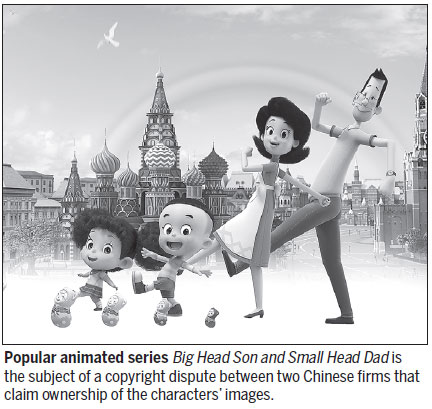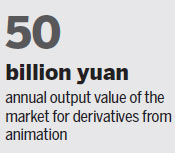Long-running dispute gets animated over popular cartoon
Beijing Intellectual Property Court held a public hearing on June 12 in the second trial of an ongoing copyright case between a cultural development company and an animation studio.
Both companies, one from Hangzhou in Zhejiang province and the other from Beijing, claim to own the rights to use the images created in the popular children's cartoon Big Head Son and Small Head Dad.
The two companies blame each other for infringing upon their claimed copyright of three leading characters from the cartoon, which were created by writer Zheng Chunhua in the early 1990s. Both companies also claim that the artist had authorized them to be the sole owner of the animation for commercial use.

The dispute has dragged on for the past two years, with both companies claiming victories in different local courts. A court in Hangzhou ruled in favor of the Hangzhou-based company, and a Beijing court ruled in favor of the Beijing-based company.
It shows challenges of China's booming cartoon industry in IPR protection, which, compared with developed countries, still has a long way to go, according to industry experts.
Last year, 83,599 minutes of animated content was created in China, as well as 39 full-length animated feature films. Four of the films generated box office revenues of more than 100 million yuan ($15.44 million) each. It is estimated that the market value of the cartoon industry in China is over 100 billion yuan.
News portal China.com.cn said that the fast development of the internet is a double-edged sword, which has boosted growth in the animation industry, but also created serious online piracy. The website called upon authorities to provide better legislature to strengthen IPR protection in its burgeoning cartoon industry.
Chen Yan, an adviser with the IPR bureau in Shenzhen, said that IPR awareness in the animation industry remains weak.
"IPR includes trademarks, patents and copyrights, and the efforts made on protection are worth it, as it can guarantee the economic value of the intellectual properties," Chen said.

Chen Wei, a veteran animator and film director, said the weakest link in China's animation industry is the upstream and downstream - how to secure investment, and how to realize the intellectual property's commercial value - and that is exactly where IPR protection should play its role.
It will create a good institutional environment for the extension of the industrial and value chain, Chen Wei said.
If IPR is carried out effectively, box office revenue should only form part of the income stream for animators, with derivatives such as merchandise creating more streams of income. This will attract more talented people to take part, making the industry more sustainable, Chen Wei said.
The annual output value of the market for derivatives from animation is about 50 billion yuan per year, growing at an average rate of 20 percent per year since 2009.
Despite this, experts said that if IPR protection in the animation industry had been more effective, the derivative market would have been even bigger.
(China Daily 06/21/2018 page17)














